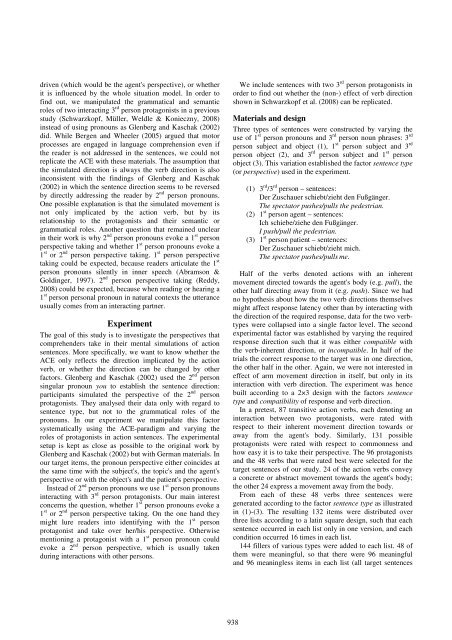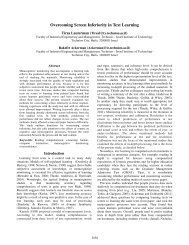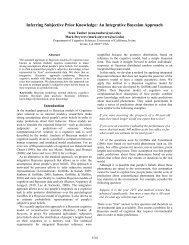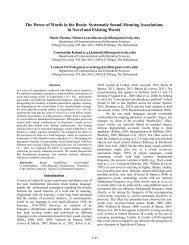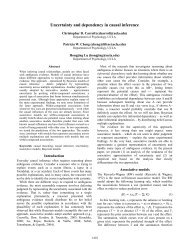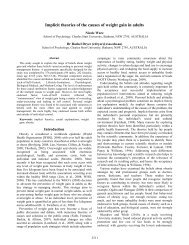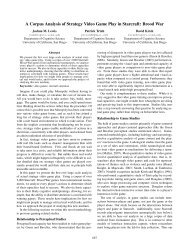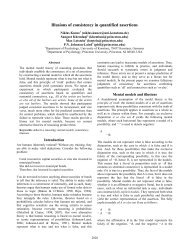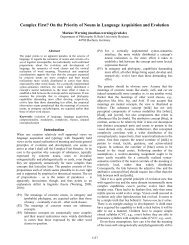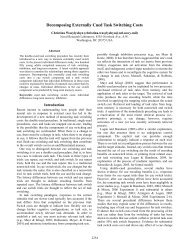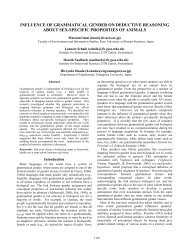Mental Simulation of Spatial Perspective during Sentence ...
Mental Simulation of Spatial Perspective during Sentence ...
Mental Simulation of Spatial Perspective during Sentence ...
Create successful ePaper yourself
Turn your PDF publications into a flip-book with our unique Google optimized e-Paper software.
driven (which would be the agent's perspective), or whether<br />
it is influenced by the whole situation model. In order to<br />
find out, we manipulated the grammatical and semantic<br />
roles <strong>of</strong> two interacting 3 rd person protagonists in a previous<br />
study (Schwarzkopf, Müller, Weldle & Konieczny, 2008)<br />
instead <strong>of</strong> using pronouns as Glenberg and Kaschak (2002)<br />
did. While Bergen and Wheeler (2005) argued that motor<br />
processes are engaged in language comprehension even if<br />
the reader is not addressed in the sentences, we could not<br />
replicate the ACE with these materials. The assumption that<br />
the simulated direction is always the verb direction is also<br />
inconsistent with the findings <strong>of</strong> Glenberg and Kaschak<br />
(2002) in which the sentence direction seems to be reversed<br />
by directly addressing the reader by 2 nd person pronouns.<br />
One possible explanation is that the simulated movement is<br />
not only implicated by the action verb, but by its<br />
relationship to the protagonists and their semantic or<br />
grammatical roles. Another question that remained unclear<br />
in their work is why 2 nd person pronouns evoke a 1 st person<br />
perspective taking and whether 1 st person pronouns evoke a<br />
1 st or 2 nd person perspective taking. 1 st person perspective<br />
taking could be expected, because readers articulate the 1 st<br />
person pronouns silently in inner speech (Abramson &<br />
Goldinger, 1997). 2 nd person perspective taking (Reddy,<br />
2008) could be expected, because when reading or hearing a<br />
1 st person personal pronoun in natural contexts the utterance<br />
usually comes from an interacting partner.<br />
Experiment<br />
The goal <strong>of</strong> this study is to investigate the perspectives that<br />
comprehenders take in their mental simulations <strong>of</strong> action<br />
sentences. More specifically, we want to know whether the<br />
ACE only reflects the direction implicated by the action<br />
verb, or whether the direction can be changed by other<br />
factors. Glenberg and Kaschak (2002) used the 2 nd person<br />
singular pronoun you to establish the sentence direction:<br />
participants simulated the perspective <strong>of</strong> the 2 nd person<br />
protagonists. They analysed their data only with regard to<br />
sentence type, but not to the grammatical roles <strong>of</strong> the<br />
pronouns. In our experiment we manipulate this factor<br />
systematically using the ACE-paradigm and varying the<br />
roles <strong>of</strong> protagonists in action sentences. The experimental<br />
setup is kept as close as possible to the original work by<br />
Glenberg and Kaschak (2002) but with German materials. In<br />
our target items, the pronoun perspective either coincides at<br />
the same time with the subject's, the topic's and the agent's<br />
perspective or with the object's and the patient's perspective.<br />
Instead <strong>of</strong> 2 nd person pronouns we use 1 st person pronouns<br />
interacting with 3 rd person protagonists. Our main interest<br />
concerns the question, whether 1 st person pronouns evoke a<br />
1 st or 2 nd person perspective taking. On the one hand they<br />
might lure readers into identifying with the 1 st person<br />
protagonist and take over her/his perspective. Otherwise<br />
mentioning a protagonist with a 1 st person pronoun could<br />
evoke a 2 nd person perspective, which is usually taken<br />
<strong>during</strong> interactions with other persons.<br />
We include sentences with two 3 rd person protagonists in<br />
order to find out whether the (non-) effect <strong>of</strong> verb direction<br />
shown in Schwarzkopf et al. (2008) can be replicated.<br />
Materials and design<br />
Three types <strong>of</strong> sentences were constructed by varying the<br />
use <strong>of</strong> 1 st person pronouns and 3 rd person noun phrases: 3 rd<br />
person subject and object (1), 1 st person subject and 3 rd<br />
person object (2), and 3 rd person subject and 1 st person<br />
object (3). This variation established the factor sentence type<br />
(or perspective) used in the experiment.<br />
(1) 3 rd /3 rd person – sentences:<br />
Der Zuschauer schiebt/zieht den Fußgänger.<br />
The spectator pushes/pulls the pedestrian.<br />
(2) 1 st person agent – sentences:<br />
Ich schiebe/ziehe den Fußgänger.<br />
I push/pull the pedestrian.<br />
(3) 1 st person patient – sentences:<br />
Der Zuschauer schiebt/zieht mich.<br />
The spectator pushes/pulls me.<br />
Half <strong>of</strong> the verbs denoted actions with an inherent<br />
movement directed towards the agent's body (e.g. pull), the<br />
other half directing away from it (e.g. push). Since we had<br />
no hypothesis about how the two verb directions themselves<br />
might affect response latency other than by interacting with<br />
the direction <strong>of</strong> the required response, data for the two verbtypes<br />
were collapsed into a single factor level. The second<br />
experimental factor was established by varying the required<br />
response direction such that it was either compatible with<br />
the verb-inherent direction, or incompatible. In half <strong>of</strong> the<br />
trials the correct response to the target was in one direction,<br />
the other half in the other. Again, we were not interested in<br />
effect <strong>of</strong> arm movement direction in itself, but only in its<br />
interaction with verb direction. The experiment was hence<br />
built according to a 2×3 design with the factors sentence<br />
type and compatibility <strong>of</strong> response and verb direction.<br />
In a pretest, 87 transitive action verbs, each denoting an<br />
interaction between two protagonists, were rated with<br />
respect to their inherent movement direction towards or<br />
away from the agent's body. Similarly, 131 possible<br />
protagonists were rated with respect to commonness and<br />
how easy it is to take their perspective. The 96 protagonists<br />
and the 48 verbs that were rated best were selected for the<br />
target sentences <strong>of</strong> our study. 24 <strong>of</strong> the action verbs convey<br />
a concrete or abstract movement towards the agent's body;<br />
the other 24 express a movement away from the body.<br />
From each <strong>of</strong> these 48 verbs three sentences were<br />
generated according to the factor sentence type as illustrated<br />
in (1)-(3). The resulting 132 items were distributed over<br />
three lists according to a latin square design, such that each<br />
sentence occurred in each list only in one version, and each<br />
condition occurred 16 times in each list.<br />
144 fillers <strong>of</strong> various types were added to each list. 48 <strong>of</strong><br />
them were meaningful, so that there were 96 meaningful<br />
and 96 meaningless items in each list (all target sentences<br />
938


